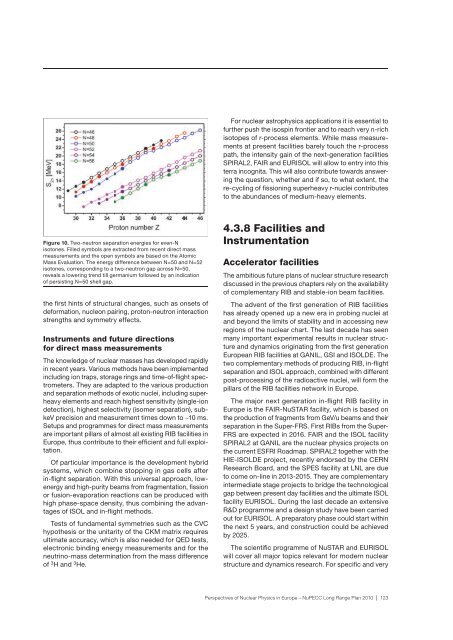Perspectives of Nuclear Physics in Europe - European Science ...
Perspectives of Nuclear Physics in Europe - European Science ...
Perspectives of Nuclear Physics in Europe - European Science ...
Create successful ePaper yourself
Turn your PDF publications into a flip-book with our unique Google optimized e-Paper software.
For nuclear astrophysics applications it is essential to<br />
further push the isosp<strong>in</strong> frontier and to reach very n-rich<br />
isotopes <strong>of</strong> r-process elements. While mass measurements<br />
at present facilities barely touch the r-process<br />
path, the <strong>in</strong>tensity ga<strong>in</strong> <strong>of</strong> the next-generation facilities<br />
SPIRAL2, FAIR and EURISOL will allow to entry <strong>in</strong>to this<br />
terra <strong>in</strong>cognita. This will also contribute towards answer<strong>in</strong>g<br />
the question, whether and if so, to what extent, the<br />
re-cycl<strong>in</strong>g <strong>of</strong> fission<strong>in</strong>g superheavy r-nuclei contributes<br />
to the abundances <strong>of</strong> medium-heavy elements.<br />
Figure 10. Two-neutron separation energies for even-N<br />
isotones. Filled symbols are extracted from recent direct mass<br />
measurements and the open symbols are based on the Atomic<br />
Mass Evaluation. The energy difference between N=50 and N=52<br />
isotones, correspond<strong>in</strong>g to a two-neutron gap across N=50,<br />
reveals a lower<strong>in</strong>g trend till germanium followed by an <strong>in</strong>dication<br />
<strong>of</strong> persist<strong>in</strong>g N=50 shell gap.<br />
the first h<strong>in</strong>ts <strong>of</strong> structural changes, such as onsets <strong>of</strong><br />
deformation, nucleon pair<strong>in</strong>g, proton-neutron <strong>in</strong>teraction<br />
strengths and symmetry effects.<br />
Instruments and future directions<br />
for direct mass measurements<br />
The knowledge <strong>of</strong> nuclear masses has developed rapidly<br />
<strong>in</strong> recent years. Various methods have been implemented<br />
<strong>in</strong>clud<strong>in</strong>g ion traps, storage r<strong>in</strong>gs and time-<strong>of</strong>-flight spectrometers.<br />
They are adapted to the various production<br />
and separation methods <strong>of</strong> exotic nuclei, <strong>in</strong>clud<strong>in</strong>g superheavy<br />
elements and reach highest sensitivity (s<strong>in</strong>gle-ion<br />
detection), highest selectivity (isomer separation), subkeV<br />
precision and measurement times down to ~10 ms.<br />
Setups and programmes for direct mass measurements<br />
are important pillars <strong>of</strong> almost all exist<strong>in</strong>g RIB facilities <strong>in</strong><br />
<strong>Europe</strong>, thus contribute to their efficient and full exploitation.<br />
Of particular importance is the development hybrid<br />
systems, which comb<strong>in</strong>e stopp<strong>in</strong>g <strong>in</strong> gas cells after<br />
<strong>in</strong>-flight separation. With this universal approach, lowenergy<br />
and high-purity beams from fragmentation, fission<br />
or fusion-evaporation reactions can be produced with<br />
high phase-space density, thus comb<strong>in</strong><strong>in</strong>g the advantages<br />
<strong>of</strong> ISOL and <strong>in</strong>-flight methods.<br />
Tests <strong>of</strong> fundamental symmetries such as the CVC<br />
hypothesis or the unitarity <strong>of</strong> the CKM matrix requires<br />
ultimate accuracy, which is also needed for QED tests,<br />
electronic b<strong>in</strong>d<strong>in</strong>g energy measurements and for the<br />
neutr<strong>in</strong>o-mass determ<strong>in</strong>ation from the mass difference<br />
<strong>of</strong> 3 H and 3 He.<br />
4.3.8 Facilities and<br />
Instrumentation<br />
Accelerator facilities<br />
The ambitious future plans <strong>of</strong> nuclear structure research<br />
discussed <strong>in</strong> the previous chapters rely on the availability<br />
<strong>of</strong> complementary RIB and stable-ion beam facilities.<br />
The advent <strong>of</strong> the fi rst generation <strong>of</strong> RIB facilities<br />
has already opened up a new era <strong>in</strong> prob<strong>in</strong>g nuclei at<br />
and beyond the limits <strong>of</strong> stability and <strong>in</strong> access<strong>in</strong>g new<br />
regions <strong>of</strong> the nuclear chart. The last decade has seen<br />
many important experimental results <strong>in</strong> nuclear structure<br />
and dynamics orig<strong>in</strong>at<strong>in</strong>g from the first generation<br />
<strong>Europe</strong>an RIB facilities at GANIL, GSI and ISOLDE. The<br />
two complementary methods <strong>of</strong> produc<strong>in</strong>g RIB, <strong>in</strong>-flight<br />
separation and ISOL approach, comb<strong>in</strong>ed with different<br />
post-process<strong>in</strong>g <strong>of</strong> the radioactive nuclei, will form the<br />
pillars <strong>of</strong> the RIB facilities network <strong>in</strong> <strong>Europe</strong>.<br />
The major next generation <strong>in</strong>-fl ight RIB facility <strong>in</strong><br />
<strong>Europe</strong> is the FAIR-NuSTAR facility, which is based on<br />
the production <strong>of</strong> fragments from GeV/u beams and their<br />
separation <strong>in</strong> the Super-FRS. First RIBs from the Super-<br />
FRS are expected <strong>in</strong> 2016. FAIR and the ISOL facility<br />
SPIRAL2 at GANIL are the nuclear physics projects on<br />
the current ESFRI Roadmap. SPIRAL2 together with the<br />
HIE-ISOLDE project, recently endorsed by the CERN<br />
Research Board, and the SPES facility at LNL are due<br />
to come on-l<strong>in</strong>e <strong>in</strong> 2013-2015. They are complementary<br />
<strong>in</strong>termediate stage projects to bridge the technological<br />
gap between present day facilities and the ultimate ISOL<br />
facility EURISOL. Dur<strong>in</strong>g the last decade an extensive<br />
R&D programme and a design study have been carried<br />
out for EURISOL. A preparatory phase could start with<strong>in</strong><br />
the next 5 years, and construction could be achieved<br />
by 2025.<br />
The scientific programme <strong>of</strong> NuSTAR and EURISOL<br />
will cover all major topics relevant for modern nuclear<br />
structure and dynamics research. For specific and very<br />
<strong>Perspectives</strong> <strong>of</strong> <strong>Nuclear</strong> <strong>Physics</strong> <strong>in</strong> <strong>Europe</strong> – NuPECC Long Range Plan 2010 | 123
















